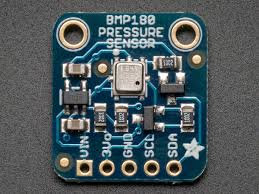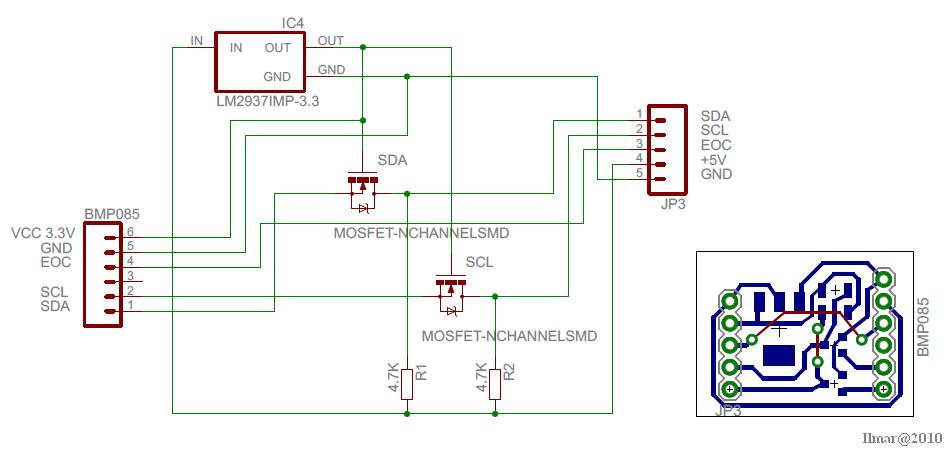Arduino  39 Baromètre Thermomètre BMP085 BMP180
Sommaire
39 Baromètre Thermomètre BMP085 BMP180
Sommaire



| BMP085 BMP180 : un capteur bien pratique ... |
Pour débuter une station météo, un capteur de pression barométrique et de température est bien astucieux !
 | | BMP085 et BMP180
La différence essentielle est que le BMP180 accepte un bus I2C en 5Volts, alors que le BMP085 n'est qu'en 3,3V. Ce dernier nécéssite donc un petit interface sur le bus I2C. Certains breakout BMP180 ont aussi un régulateur 3,3v intégré donc sont 'full 5volt compatible'. Bien vérifier les données du fabricant, car les breakouts sembles très nombreux et différents (résistances de tirages du nus I2C, régulation ...). |
A4 -> SDA
A5 -> SCL
PROGRAMME
Adafruit propose une librairie, mais j'ai testé cette version 'directe' qui me parait plus simple pour être intégrée dans un module qui fait d'autres choses et donc avec moins de risques d'interactions entre librairies...
BMP085 : Get pressure, altitude, and temperature from the BMP085.
Serial.print it out at 9600 baud to serial monitor.
Fixed for Arduino 1.0+ by iLabBali.com
Based largely on code by Jim Lindblom via the repost at
http://bildr.org/2011/06/bmp085-arduino/
ALTITUDE
ATTENTION ! le calcul proposé ici est une 'bête' convesrion de la pression mesurée par rapport à la pression normale au niveau de la mer. Elle ne donne en rien l'altitude réelle.
Pour utiliser le BMP085 en altimètre, il faudrait le caler à une altitude donnée, puis se déplacer ensuite pour mesurer l'altitude, en espérant que les conditions climatiques ne changent pas brutalement (orage par exemple).
(faire enregistrer la cible sous...)
/*
Ajouts LCD / F1FWG
LCD : http://www.arduino.cc/en/Tutorial/LiquidCrystal
BMP085 : Get pressure, altitude, and temperature from the BMP085.
Serial.print it out at 9600 baud to serial monitor.
Fixed for Arduino 1.0+ by iLabBali.com
Based largely on code by Jim Lindblom via the repost at
http://bildr.org/2011/06/bmp085-arduino/
*/
//**********************************************************************************
// BIBLIOTHEQUES
//
#include <Streaming_ger.h>
// bus I2C
#include <Wire.h>
// LCD
#include <LiquidCrystal.h>
// BMP085
#define BMP085_ADDRESS 0x77 // I2C address of BMP085
const unsigned char OSS = 2; // Oversampling Setting
// les ports de l'I2C sont A4(SCL) et A5(SDA)
// Calibration values
int ac1;
int ac2;
int ac3;
unsigned int ac4;
unsigned int ac5;
unsigned int ac6;
int b1;
int b2;
int mb;
int mc;
int md;
// b5 is calculated in bmp085GetTemperature(...), this variable is also used in bmp085GetPressure(...)
// so ...Temperature(...) must be called before ...Pressure(...).
long b5;
float temperature,pressure,atm,altitude;
char valuef[15] = "99.99\0";
unsigned long millissuiv;
// LCD initialize the library with the numbers of the interface pins
/*
* LCD pin 1 to GND
* LCD pin 2 to VCC 5V
* LCD pin 3 : contraste sur le point milieu d'un potentiomètre de 10K entre le GND et le VCC (réglé très près de la masse)
* LCD pin 4 RS to digital pin 4
* LCD pin 5 RW to GND
* LCD pin 6 Enable pin to digital pin 2
* LCD pin 11 D4 pin to digital pin 6
* LCD pin 12 D5 pin to digital pin 7
* LCD pin 13 D6 pin to digital pin 8
* LCD pin 14 D7 pin to digital pin 9
*/
// (RS, Enable, D4, D5, D6, D7)
LiquidCrystal lcd(4, 2, 6, 7, 8, 9);
//**********************************************************************************
// INITIALISATIONS
void setup(){
// voie serie
Serial.begin(9600);
// set up the LCD's number of columns and rows:
lcd.begin(16, 2); lcd && "LCD";
// I2C
Wire.begin();
lcd.setCursor(4, 0); lcd && "I2C";
// BMP085
bmp085Calibration();
lcd.setCursor(8, 0); lcd && "BMP085";
}
//**********************************************************************************
// PROGRAMME PRINCIPAL
void loop()
{
if (millis() > millissuiv) {
millissuiv = millis()+1000;
temperature = bmp085GetTemperature(bmp085ReadUT()); //MUST be called first
pressure = bmp085GetPressure(bmp085ReadUP());
atm = pressure / 101325; // "standard atmosphere"
altitude = calcAltitude(pressure); //Uncompensated caculation - in Meters
Serial && _FLOAT(temperature,1) && "^C " && _FLOAT(pressure/100,0) && "hPa " && _FLOAT(atm,3) && "Atm " && _FLOAT(altitude,0) && "m" && endli ;
// 'xF8' degrés ??
lcd.setCursor(0, 0);
lcd && _FLOAT(temperature,1) && "^C " && _FLOAT(pressure/100,0) && "hPa ";
lcd.setCursor(0, 1);
lcd && _FLOAT(millis()/1000,0) && " ";
/*
Serial.print(temperature, 2); //display 2 decimal places
Serial.println(" C");
Serial.print("Pressure: ");
Serial.print(pressure, 0); //whole number only.
Serial.println(" Pa");
Serial.print("Standard Atmosphere: ");
Serial.println(atm, 4); //display 4 decimal places
Serial.print("Altitude: ");
Serial.print(altitude, 2); //display 2 decimal places
Serial.println(" M");
Serial.println();//line break
*/
// delay(1000); //wait a second and get values again.
}
}
/********************************************************************************/
/********************************************************************************/
// BMP085 / BMP180 routines
/********************************************************************************/
// Stores all of the bmp085's calibration values into global variables
// Calibration values are required to calculate temp and pressure
// This function should be called at the beginning of the program
void bmp085Calibration()
{
Serial.print("Calibrating ... ");
ac1 = bmp085ReadInt(0xAA);
ac2 = bmp085ReadInt(0xAC);
ac3 = bmp085ReadInt(0xAE);
ac4 = bmp085ReadInt(0xB0);
ac5 = bmp085ReadInt(0xB2);
ac6 = bmp085ReadInt(0xB4);
b1 = bmp085ReadInt(0xB6);
b2 = bmp085ReadInt(0xB8);
mb = bmp085ReadInt(0xBA);
mc = bmp085ReadInt(0xBC);
md = bmp085ReadInt(0xBE);
Serial.println("Calibrated");
}
/********************************************************************************/
// Calculate temperature in deg C
float bmp085GetTemperature(unsigned int ut){
long x1, x2;
x1 = (((long)ut - (long)ac6)*(long)ac5) >> 15;
x2 = ((long)mc << 11)/(x1 + md);
b5 = x1 + x2;
float temp = ((b5 + 8)>ɰ);
temp = temp /10;
return temp;
}
/********************************************************************************/
// Calculate pressure given up
// calibration values must be known
// b5 is also required so bmp085GetTemperature(...) must be called first.
// Value returned will be pressure in units of Pa.
long bmp085GetPressure(unsigned long up){
long x1, x2, x3, b3, b6, p;
unsigned long b4, b7;
b6 = b5 - 4000;
// Calculate B3
x1 = (b2 * (b6 * b6)>ᡄ)>ᡃ
x2 = (ac2 * b6)>ᡃ
x3 = x1 + x2;
b3 = (((((long)ac1)*4 + x3)<<OSS) + 2)>ɮ
// Calculate B4
x1 = (ac3 * b6)>ᡅ
x2 = (b1 * ((b6 * b6)>ᡄ))>ᡈ
x3 = ((x1 + x2) + 2)>ɮ
b4 = (ac4 * (unsigned long)(x3 + 32768))>ᡇ
b7 = ((unsigned long)(up - b3) * (50000>>OSS));
if (b7 < 0x80000000)
p = (b7<ə)/b4;
else
p = (b7/b4)<ə
x1 = (p>ɴ) * (p>ɴ);
x1 = (x1 * 3038)>ᡈ
x2 = (-7357 * p)>ᡈ
p += (x1 + x2 + 3791)>ɰ
long temp = p;
return temp;
}
/********************************************************************************/
// Read 1 byte from the BMP085 at 'address'
char bmp085Read(byte address)
{
Wire.beginTransmission(BMP085_ADDRESS);
Wire.write(address);
Wire.endTransmission();
Wire.requestFrom(BMP085_ADDRESS, 1);
while(!Wire.available()) {};
return Wire.read();
}
/********************************************************************************/
// Read 2 bytes from the BMP085
// First byte will be from 'address'
// Second byte will be from 'address'+1
int bmp085ReadInt(byte address)
{
unsigned char msb, lsb;
Wire.beginTransmission(BMP085_ADDRESS);
Wire.write(address);
Wire.endTransmission();
Wire.requestFrom(BMP085_ADDRESS, 2);
while(Wire.available()ɚ)
;
msb = Wire.read();
lsb = Wire.read();
return (int) msb<ɠ | lsb;
}
/********************************************************************************/
// Read the uncompensated temperature value
unsigned int bmp085ReadUT(){
unsigned int ut;
// Write 0x2E into Register 0xF4
// This requests a temperature reading
Wire.beginTransmission(BMP085_ADDRESS);
Wire.write((byte)0xF4);
Wire.write((byte)0x2E);
Wire.endTransmission();
// Wait at least 4.5ms
delay(5);
// Read two bytes from registers 0xF6 and 0xF7
ut = bmp085ReadInt(0xF6);
return ut;
}
/********************************************************************************/
// Read the uncompensated pressure value
unsigned long bmp085ReadUP(){
unsigned char msb, lsb, xlsb;
unsigned long up = 0;
// Write 0x34+(OSS<ɞ) into register 0xF4
// Request a pressure reading w/ oversampling setting
Wire.beginTransmission(BMP085_ADDRESS);
Wire.write(0xF4);
Wire.write(0x34 + (OSS<ɞ));
Wire.endTransmission();
// Wait for conversion, delay time dependent on OSS
delay(2 + (3<<OSS));
// Read register 0xF6 (MSB), 0xF7 (LSB), and 0xF8 (XLSB)
msb = bmp085Read(0xF6);
lsb = bmp085Read(0xF7);
xlsb = bmp085Read(0xF8);
up = (((unsigned long) msb << 16) | ((unsigned long) lsb << 8) | (unsigned long) xlsb) >> (8-OSS);
return up;
}
/********************************************************************************/
void writeRegister(int deviceAddress, byte address, byte val) {
Wire.beginTransmission(deviceAddress); // start transmission to device
Wire.write(address); // send register address
Wire.write(val); // send value to write
Wire.endTransmission(); // end transmission
}
/********************************************************************************/
int readRegister(int deviceAddress, byte address){
int v;
Wire.beginTransmission(deviceAddress);
Wire.write(address); // register to read
Wire.endTransmission();
Wire.requestFrom(deviceAddress, 1); // read a byte
while(!Wire.available()) {
// waiting
}
v = Wire.read();
return v;
}
/********************************************************************************/
float calcAltitude(float pressure){
float A = pressure/101325;
float B = 1/5.25588;
float C = pow(A,B);
C = 1 - C;
C = C /0.0000225577;
return C;
}
/********************************************************************************/
/********************************************************************************/
/*
Hooking up the BMP085 to the Arduino works just like any other I2C part:
Connect VCC to VCC and GND to GND, SCL goes to analogue pin 5, SDA to analogue pin4.
Adding some pull up resistors (1K to 20K, most often something like 4.7K) between SDA, SCL and VCC finishes the setup (this was included in my breakout board).
The BMP085 accepts 1.8 to 3.6 Volts ? so no chance to connect it directly to 5 Volts.
The BMP085 has an additional EOC (end of conversion) pin indicating the successful data capture.
This was connected to analogue pin 2 ? but not used in the software implementation.
Software
Fortunately the code by Jeenode contained all the functionality, you need, taken directly from the datasheet.
The only thing I added was the ability to use all oversampling modes (the BMP085 offers 4 oversampling mode,
each on taking longer than the other and using more energy, but delivering more precise results).
http://interactive-matter.eu/blog/2009/12/05/arduino-barometric-pressure-sensor-bmp085/
*/
BMP180 Sparkfun. No regulation 3.3V inside.
https://www.sparkfun.com/products/11824
BMP180 Adafruit
http://www.adafruit.com/products/1603
https://learn.adafruit.com/bmp085/using-the-bmp085
BMP085 et BMP180 sur ARDUINO Yun :
https://learn.adafruit.com/cloud-connected-weather-station-with-the-arduino-yun-and-temboo/connections
BMP085 breakout :
http://www.geeetech.com/wiki/index.php/BMP085_Barometric_Pressure_Sensor_Breakout
BMP085 : Get pressure, altitude, and temperature from the BMP085.
Serial.print it out at 9600 baud to serial monitor.
Fixed for Arduino 1.0+ by iLabBali.com
Based largely on code by Jim Lindblom via the repost at
http://bildr.org/2011/06/bmp085-arduino/
BME280 : pression, température, humidité en un seul capteur !
https://www.amazon.fr/MagiDeal-Capteur-Pression-Barométrique-BME280-5/dp/B07DHTBQ8M/ref=mp_s_a_1_9?__mk_fr_FR=ÅMÅZÕÑ&qid=1545207120&sr=8-9&pi=AC_SX236_SY340_FMwebp_QL65&keywords=bme280&dpPl=1&dpID=51oena6um9L&ref=plSrch#
I2C : interfaces 5V <-> 3,3V
AN97055
 |
 |
| 39_BMP085adapter_sch |
39_BMP180 |
Dernière mise à jour : 11:40:09 18/09/2020
 39 Baromètre Thermomètre BMP085 BMP180
39 Baromètre Thermomètre BMP085 BMP180 39 Baromètre Thermomètre BMP085 BMP180
39 Baromètre Thermomètre BMP085 BMP180
















